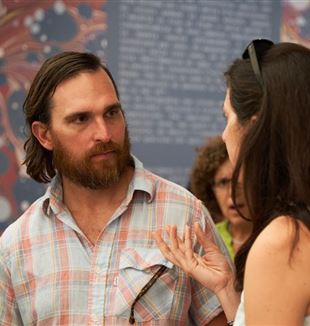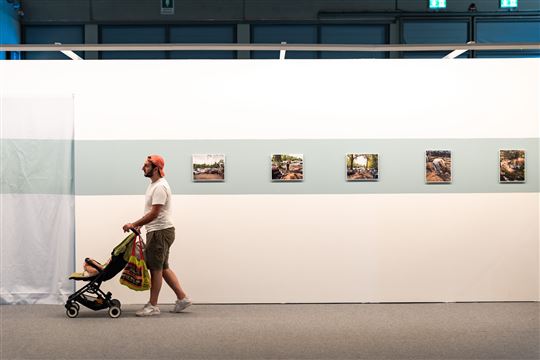
The shock of the other
“We live in an era of tribalism. But all of us want to be seen, heard, and loved.” In Traces, an interview with Curran Hatleberg, the American photographer who was featured in an exhibit at the Rimini Meeting.Curran Hatleberg is an artist who was born in Washington DC in 1982. He graduated from Yale with a master in photography. His works have been displayed at the Whitney Biennial in New York, the largest event in the contemporary American art world. In 2022, he published River’s Dream, a book containing a collection of his work in the southeastern US between 2010 and 2020. “They are places that I knew nothing about, and I was curious to know what happens in daily life there. I immersed myself completely in this reality, relying on people I met by chance. I ate with them, I slept in their homes, I shared in their lives. In today’s America, which is so polarized, I tried to find the other side of my country.” I invited Hatleberg to this year’s Rimini Meeting where he displayed all sixty-five shots in the volume. He was there with me and the volunteers for a week. A few days after the event ended, I reached him on the phone while he was on his way back to Baltimore from one of his trips to the Midwest. Seventeen hours by car. “Now I am somewhere in Iowa.”
What are your impressions of the days you spent at the Rimini Meeting?
I had no expectations. I had no idea of what I would find there. You were the only person I knew, but I sensed that it would be possible to present my work in the right way. I knew almost nothing about the Rimini Meeting. The thing that surprised me the most is the number of people. And also the devotion and dedication of the volunteers. It is wonderful to see that there are people who dedicate their free time to an event like this. It is something special.
At the exhibit you met and spoke with many visitors.
It is exciting to have conversations of this kind outside the context of the art world. People felt free to speak their minds. It is something very rare. They asked me candid questions, shared honest observations. They reminded me a little of my parents, who are intimidated by museums and galleries, but none of the questions they asked were out of place.
What were the conversations that struck you the most?
My favorite moments were when people came up to me and told me that they did not like the exhibit. That is practically impossible in the art world. It was fun. Normally when people have criticisms, they keep them to themselves. Instead, they approached me and asked me why I had photographed this or that thing. Or they would tell me that they found the exhibit boring and did not see what the point of it was. But perhaps the strangest question was another one...
Which one?
Many people asked me if I was religious.
Did that bother you?
No, not at all. Even though I am not. But it is interesting that they asked me because, in my opinion, they were asking me something else. It was as if they were offering a positive judgment of me. Was it important for them that I was religious? It is a fascinating question.
No one told you that they liked the exhibit?
One day a mother and her teenage daughter came up to me. The mother said, “I had forgotten how beautiful the world is…” And she started crying and could not finish her sentence. The daughter looked embarrassed and did not know what to do. It was a striking moment because the hope of an artist is always that your work will resonate with another person. But you never know if that will really happen. I am sure that that woman was not expecting to burst into tears. She was probably thinking of something completely different and my photographs sparked something in her. It was one of the most moving moments for me.
But, in general, did you have the impression that people understood what you were trying to communicate with River’s Dream?
When you finish a work and you show it to the world, you no longer have control over it. And I cannot say whether I was able to communicate what I wanted to say. People may have taken home with them something that I had never thought of or something contrary to my intentions. This is what distinguishes works of art, which ask questions and give no answers. But I hope that people grasped the humanistic quality of my images.
Is that enough for you?
Someone would approach me and say, “I did not like anything, except for the photo with the sunset…,” which for me is the most ordinary one. Then there were other people who told me that at first they felt uneasy, but then, as they continued, they got a sense of redemption.
Read also - What is worth living for?
Was this what you wanted to achieve?
Actually, I find that in all of the photographs there is an extraordinary beauty. But it is true that the exhibit concludes with a sort of moment of grace. There are three photos in which a woman finds herself in front of a praying mantis. For me this image is the possibility of elevation in the face of an everyday miracle. A moment of transcendence in front of a kind of beauty that is always around us but that normally fails to capture our attention.
You also met other guest speakers at the Rimini Meeting.
The beauty of traveling, photographing, and meeting people is the shock of not being recognized. This is the experience of running into something that is completely different from you. That is how Rimini was. I had never met a Coptic bishop before. I have never been to Egypt. I had never been at dinner with a Palestinian and an Israeli who talked about their friendship despite the fact that their daughters were killed in reciprocal attacks. It is a shock because it is inside the difference that you realize that we share the same humanity. They were encounters that I had not expected. They were gifts.
At the presentation of the exhibit, you asked yourself, “In these divisive times, how can one create a shift in deeply rooted attitudes and hardline positions if not through experiences with others that show us how to imagine other possibilities?”
The encounter with someone who is different from me and sharing life together allow us to remember that we are all human beings. We do our best. All of us want to be seen, heard, loved. We live in an era of tribalism, especially in the United States, and if we were able to step outside of that logic, we could see ourselves reflected in the other. The differences that divide us are really only on the surface.
You also said, “I believe my work is about trying to understand what family and community mean.” Why are you interested in that?
It is our primary need. In my life I have felt lost and adrift. Through these bonds, even with some of the people I have photographed, I have felt loved.